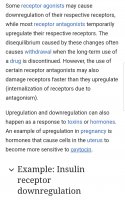I find this aspect of the opioid network highly interesting:
-1Opioid Receptors
Kappa opioid receptors are located on dopamine axon terminals (Svingos et al., 2001).
-The κ-opioid receptor binds to the endogenous ligand, dynorphin, and acts to decrease dopamine release.151
The dynorphin/kappa opioid receptor (KOR) system is implicated in the “dark side” of addiction, in which stress exacerbates maladaptive responses to drug and alcohol exposure. For example, acute stress and acute ethanol exposure result in an elevation in dynorphin, the KOR endogenous ligand. Activation of KORs results in modulation of several neurotransmitters;
Specifically, KOR activation has an inhibitory effect on dopamine release, thereby influencing reward processing.
Repeated stimulation of KORs, for example, via chronic drug and/or stress exposure, results in increased function of the dynorphin/KOR system. This augmentation in KOR function shifts the homeostatic balance in favor of an overall reduction in dopamine signaling via either by reducing dopamine release or by increasing dopamine transporter function.
KORs may also be involved in driving excessive consumption of food, contributing to the risk of developing obesity. While some studies have shown that KOR agonists reduce drug intake, other studies have shown that antagonists reduce addiction-like behaviors, demonstrating therapeutic potential. For example, KOR inhibition reduces ethanol intake in dependent animals, motivation to self-administer cocaine in chronic stress-exposed animals, and food consumption in obese animals.
Feel free to leave a comment below on what you have discovered:
-1Opioid Receptors
Kappa opioid receptors are located on dopamine axon terminals (Svingos et al., 2001).
-The κ-opioid receptor binds to the endogenous ligand, dynorphin, and acts to decrease dopamine release.151
The dynorphin/kappa opioid receptor (KOR) system is implicated in the “dark side” of addiction, in which stress exacerbates maladaptive responses to drug and alcohol exposure. For example, acute stress and acute ethanol exposure result in an elevation in dynorphin, the KOR endogenous ligand. Activation of KORs results in modulation of several neurotransmitters;
Specifically, KOR activation has an inhibitory effect on dopamine release, thereby influencing reward processing.
Repeated stimulation of KORs, for example, via chronic drug and/or stress exposure, results in increased function of the dynorphin/KOR system. This augmentation in KOR function shifts the homeostatic balance in favor of an overall reduction in dopamine signaling via either by reducing dopamine release or by increasing dopamine transporter function.
KORs may also be involved in driving excessive consumption of food, contributing to the risk of developing obesity. While some studies have shown that KOR agonists reduce drug intake, other studies have shown that antagonists reduce addiction-like behaviors, demonstrating therapeutic potential. For example, KOR inhibition reduces ethanol intake in dependent animals, motivation to self-administer cocaine in chronic stress-exposed animals, and food consumption in obese animals.
Feel free to leave a comment below on what you have discovered:

